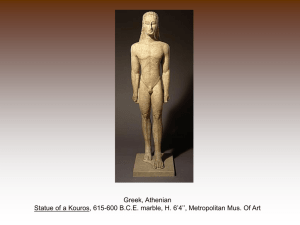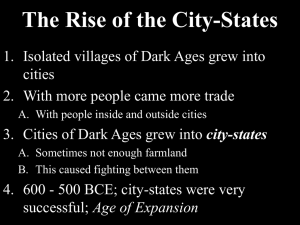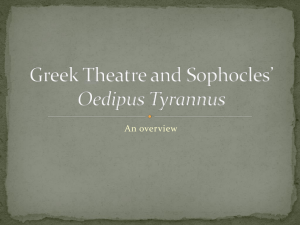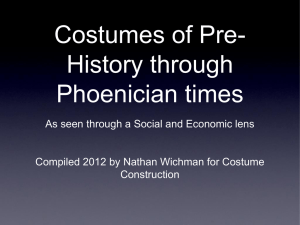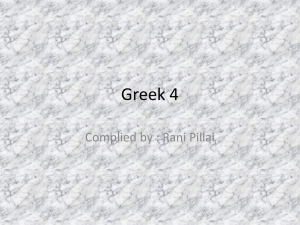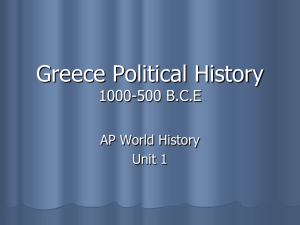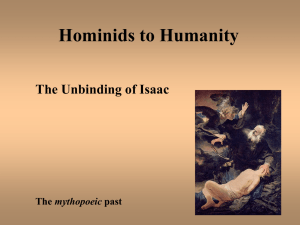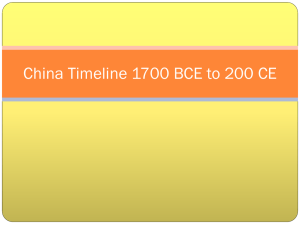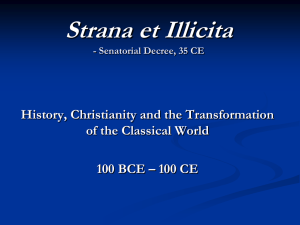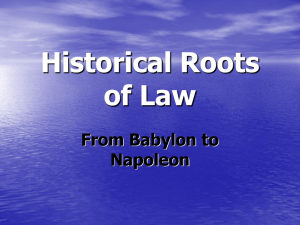Greek 2 PPT - Ashland Independent Schools
advertisement
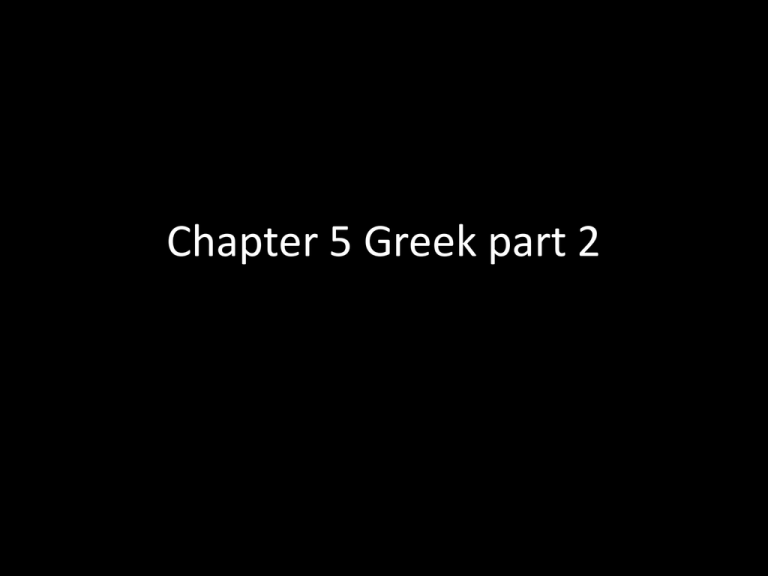
Chapter 5 Greek part 2 Early and High Classical Periods (5th century BCE) 2 Compare: Archaic vs Early Classical Kritios Boy is the earliest known example of contrapposto (counterbalance), a relaxed and natural stance. Notice how his weight shifts to his left leg, with a slight dip of his right leg and how his head turns slightly to his right. This is the transitional piece between Archaic and Classical Notice absence of Archaic smile It was so named because it was believed to be by the artist Kritios Figure 5-34 Kritios Boy, from the Acropolis, Athens, Greece, ca. 480 BCE. Marble, 2’ 10” high. Acropolis Museum, Athens. 4 Contrapposto Riace Warriors • Found in 1972 by a scuba diver off the coast of Riace. • The eyes are inlaid with bone and glass, the teeth are in silver and the nipples are in copper. • They originally held spears and shields • A good example of Early Classical in its use of contrapposto and the realistic musculature This Riace Warrior, like most Classical Greek statues, was sculpted in bronze. Most Classical bronzes have not survived. Much of the “Classical Greek” sculptures today are actually Roman marble copies. Figure 5-35 Warrior, from the sea off Riace, Italy, ca. 460–450 BCE. Bronze, 6’ 6” high. Museo Archeologico Nazionale, Reggio Calabria. 7 Zeus or Poseidon Graceful turn of the body with slightly lifted back foot Zeus is about to throw a thunderbolt or Poseidon holding a trident It is an idealized, youthful body but has an older face. Fig. 5-38 Zeus (or Poseidon?), from the sea off Cape Artemision, Greece, ca. 460– 450 BCE. Bronze, 6’ 10” high. National Archaeological Museum, Athens. 8 The Discus Thrower • Greek name: Diskoblos • There is a major weight shift - an extreme use of contrapposto • He is in motion, in mid-swing • In real life it would be impossible to throw the discus this way - yet it works optically - to create that illusion of movement • The face is expressionless - some say he is in thought • He has an idealized heroic body • The use of negative space opens large areas of the sculpture. Thanks to the Romans’ interest in Greek sculpture many Greek sculptures have been preserved in marble copies The Roman copies are not perfect replicas. Often, because marble is heavier, they had to add portions to help hold the sculpture up like the tree trunk to the right. Also, they would change aspects of the sculpture to suit their needs - like mirroring it. Figure 5-39 MYRON, Diskobolos (Discus Thrower). Roman marble copy of a bronze original of ca. 450 BCE, 5’ 1” high. Museo Nazionale Romano—Palazzo Massimo alle Terme. 10 Spear Bearer • Greek name: Doryphoros • Alternating and counterbalance of tense and relaxed elements of the body; left arm and right leg are tense and weight bearing while the right arm and left leg are relaxed. • He has broad shoulders, a thick torso and ideal muscular body • His hand once held a spear Spear Bearer • Artist: Polykleitos • He used a mathematical approach which focused on a variety of proportions. For example: the head is 1/7 of the height of the body. • He felt that perfection was in how each part related to each other and the whole. • He named it Canon Figure 5-40 POLYKLEITOS, Doryphoros (Spear Bearer). Roman marble copy from Pompeii, Italy, after a bronze original of ca. 450–440 BCE, 6’ 11” high. Museo Archeologico Nazionale, Naples. 14 Pediment of Temple of Zeus • Story of local importance: chariot race b/n King Oinomaos and Pelops • Oinomaos challenged any suitor of his only daughter (Hippodameia) to a chariot race. If he won they were killed, if they won they were able to marry his daughter. Oinomaos had divine horses that his father Ares gave him and won every race. Pelops, determined to marry Hippodameia, bribed Myrtilos a servant of Oinomaos to rig the royal chariot. The chariot fell apart, killing Oinomaos. Instead of paying Myrtilos, Pelops killed him. Before he died, Myrtilos cursed Pelops and his descendents. He and his descendents became the subject of Aeschylus’ Oresteia plays Zeus stands in the middle, Oinomaos and his wife are on one side and Pelops and Hippodameia on the other. On both sides their respective chariots are shown. The events have yet to occur, all are calm except one figure - a seer who has a shocked expression on his face because he knows what is about to happen. Figure 5-31 East pediment from the Temple of Zeus, Olympia, Greece, ca. 470–456 BCE. Marble, 87’ wide. Archaeological Museum, Olympia. 17 He is a rare depiction of old age His expression is also a rarity of Classical sculpture, it was not a regular feature until the Hellenistic age Figure 5-32 Seer, from the east pediment of the Temple of Zeus, Olympia, Greece, ca. 470– 456 BCE. Marble, full figure 4’ 6” high; detail 3’ 2 1/2” high. Archaeological Museum, Olympia. 18 Athena, Herakles and Atlas • Metopes of the Zeus temple depicts the 12 labors of Herakles - the founder of the Olympic games • Herakles is holding up the sky (with the help of Athena and a cushion) while Atlas went on a dangerous journey to fetch the golden apples of the Hesperites • The high relief figures stand serenely just as the ones in the pediment. Metopes of Zeus temple depicts the 12 labors of Herakles - the founder of the Olympic games Herakles is holding up the sky (with the help of Athena and a cushion) while Atlas went on a dangerous journey to fetch the golden apples of the Hesperites Figure 5-33 Athena, Herakles, and Atlas with the apples of the Hesperides, metope from the Temple of Zeus, Olympia, Greece, ca. 470–456 BCE. Marble, 5’ 3” high. Archaeological Museum, Olympia. 20 Pericles: •Elected stratego, general of Athens 15 times •Instrumental in rebuilding and beautifying Athens after second Persian invasion. Most noteworthy: Acropolis •Notice his idealized appearance: unblemished features, his aloof expression Figure 5-41 KRESILAS, Pericles. Roman marble herm copy of a bronze original of ca. 429 BCE. Full herm 6’ high; detail 4’ 6 1/2” high. Musei Vaticani, Rome. 21 Pericles and the Acropolis • The centerpiece of his great builidng project on the Acropolis was the Parthenon (Temple of Athena Parthenos) • Construction of the gateway - Propylaia began shortly after the completion of the Parthenon • The last two buildings were finished after Pericles’ death - the Erechtheion and the Temple of Athena Nike • The greatest architects and sculptors were called upon to help create the Acropolis Figure 5-42 Aerial view of the Acropolis looking southeast, Athens, Greece. 23 Parthenon • The Parthenon was transformed into a church during the Byzantine era. • It later became a mosque after the invasion of the Ottomans • It was remodeled each time: – Christians - removed statue of Athena and added an Apse – Muslims - added a minaret • In 1687, when the Venetians besieged the Acropolis, one of their rockets hit an ammunition depot Turks installed there, which ruined most of the the interior. Many of the remaining sculptures were removed and some were broken when they were dropped on the ground. Parthenon • 447-438 BCE, architects - Iktinos and Kallikrates, over-seer of sculpture - Phidias. It is a Doric structure • Proportion: x = 2y + 1, ex: short side 8 columns and long 17. Everything in the temple fits this proportion. Proportion= harmony • Even with the importance of perfection through proportion, there are some irregularities – Stylobate curves upward toward the center forming a shallow dome – Columns lean in slightly and the corner ones are 2 in. thicker – Portions are Ionic (treasury and inner frieze) Parthenon • Though it is a Doric structure, it did contain some Ionic elements: – An interior room used for a treasury had four Ionic columns – An inner frieze around the cella was Ionic * This mixture of Doric and Ionic characterizes the 5th century buildings of the Acropolis Figure 5-44 IKTINOS and KALLIKRATES, Parthenon, (Temple of Athena Parthenos, looking southeast), Acropolis, Athens, Greece, 447–438 BCE. 27 Figure 5-45 Plan of the Parthenon, Acropolis, Athens, Greece, with diagram of sculptural program (after Andrew Stewart), 447–432 BCE. 28 Chryselephatine - gold and ivory 38 ft tall The Parthenon was for the most part built around the statue. She is representative of the Athenian victory over the Persians. Her sandals contain images of centaurmachy (Persians as barbarians). Her shield contains relief scenes from the battle of the Greeks and Amazons. It also has a painting of giantomachy on the interior. Each is representative of triumph of order over chaos. Figure 5-46 PHIDIAS, Athena Parthenos, in the cella of the Parthenon, Acropolis, Athens, Greece, ca. 438 BCE. Model of the lost chryselephantine statue. Royal Ontario Museum, Toronto. 29 Pediments of the Parthenon • The west pediment depicted the contest between Athena and Poseidon to determine who would be Athen’s patron • The east pediment depicted the birth of Athena – The center was damaged when the the apse was added to convert it into a church • Phidias, who designed the composition, discovered an entirely new way to deal with the awkward triangular frame of the pediment. By reclining the figures beneath the raking cornices – they appear to be relaxed, yet still naturalistic. Figure 5-48 Helios and his horses, and Dionysos (Herakles?), from the east pediment of the Parthenon, Acropolis, Athens, Greece, ca. 438–432 BCE. Marble, greatest height 4’ 3”. British Museum, London. 31 Figure 5-49 Three goddesses (Hestia, Dione, and Aphrodite?), from the east pediment of the Parthenon, Acropolis, Athens, Greece, ca. 438–432 BCE. Marble, greatest height 4’ 5”. British Museum, London. 32 Parthenon Friezes • The best preserved metopes of the exterior depict the battle of Laptihs and centaurs, a combat in which Theseus of Athens played a major role. • The interior Ionic frieze, depicts what most scholars believe to be the Panathenaic Festival procession which took place in Athens every four years. – In the frieze, the gods are spectators to the parading Athenians Figure 5-50 Details of the Panathenaic Festival procession frieze, from the Parthenon, Acropolis, Athens, Greece, ca. 447–438 BCE. Marble, 3’ 6” high. Horsemen of north frieze (top), British Museum, London; seated gods and goddesses (Poseidon, Apollo, and Artemis) of east frieze (center), Acropolis Museum, Athens; and elders and maidens of east frieze (bottom), Louvre, Paris.34 Propylaia • Propylaia - 437-2 BCE monumental entrance to Acropolis, architect Minesikles. • It was built on a steep slope, Minesikles was successful in disguising the change in ground by splitting the builidng into eastern and western sections - each one resembling a Doric façade • Between the front columns was a ramp for the processions that occurred during the Panthenaic festival. Inside tall Ionic columns supported the spilt-level roof • It was not finished according to plan because of lack of funding due to the Peloponnesian War. Only one side wing was completed on the Northwest side. It is significant because in Roman times it housed a pinakotheke (picture gallery). It is uncertain if that was its original intent. But if it was, it was the first recorded structure built to display paintings. Figure 5-51 MNESIKLES, Propylaia (looking southwest), Acropolis, Athens, Greece, 36 437–432 BCE. Erechtheion • 421 - 05 BCE, Ionic, architect unknown • Built to replace the Archaic Athena temple destroyed by the Persians, however it served as a multiple shrine. • It houses tombs and shrines of various gods and demigods including two former leaders of Athens - Erectheus and Kekrops • Asymmetrical design is unique. Also, each wall has different character and rests on a different ground level. Figure 5-52 Erechtheion (looking northwest), Acropolis, Athens, Greece, ca. 421–405 BCE. 38 Figure 5-53 Plan of the Erechtheion, Acropolis, Athens, Greece, ca. 421– 405 BCE. 39 On south porch of Erectheion. Caryatid resemble Archaic korai, however they exhibit the weight shift characteristic of 5th century statues. The flute like drapery conceals the stiff, weight bearing legs. However, the sculptor was still able to make them seem flexible like the human body. Figure 5-54 Caryatid from the south porch of the Erechtheion, Acropolis, Athens, Greece, ca. 421–405 BCE. Marble, 7’ 7” high. British Museum, London. 40 Temple of Athena Nike • 427-4, Kallikrates - architect, Ionic • Amphiprostyle - 4 columns on east and east façade • Part of the frieze was devoted to the decisive battle at Marathon. • A parapet was built at the bastion’s ege in 410 BCE decorated with reliefs. The theme was Nike (victory) who is depicted in a variety of ways. Figure 5-55 KALLIKRATES, Temple of Athena Nike (looking southwest), Acropolis, Athens, Greece, ca. 427–424 BCE. 42 Nike Adjusting Her Sandal • A High relief sculpture depicting Nike adjusting her sandal – though an awkward position, she is rendered in an elegant and graceful way. • Her garments cling so tightly to the body that they seem to be drenched with water. Thus, revealing portions of her body that would otherwise be hidden by heavy fabric. Figure 5-56 Nike adjusting her sandal, from the south side of the parapet of the Temple of Athena Nike, Acropolis, Athens, Greece, ca. 410 BCE. Marble, 3’ 6” high. Acropolis Museum, Athens. 44 Late Classical Period (4th century BCE) 45 The rise of Macedon • In 338 BCE, the Greeks suffered a devastating loss and relinquished their independence to Phillip II, king of Macedon. After his assassination, his son Alexander the Great succeeded him. • This defeat, the political upheaval and chaos of the time had a profound impact on The Greeks and the art they created. • In the fifth century they believed in attempting to achieve perfect statues and to use correct mathematical formulas for constructing temples. • In the fourth century, they began to focus more on representing the real world appearances rather than on the ideal world of perfect beings. Praxiteles • The new approach to art is apparent in the work of Praxiteles. • He continued depicting the themes favored by sculptors of the High Classical the gods. Although they kept their superhuman beauty, they lost some of their solemn expression and became more humanized. Aphrodite of Knidos •Bold step to render a goddess in the nude – it was so controversial that is was rejected by a city before the city of Knidos purchased it. People traveled to Knidos just to see the statue. •It became popular because of the rarity of representing a female nude. The only depictions of female nudes were of servants, never a goddess or noblewoman. It was considered of low character for a woman to be represented nude. •She is also engaged in a trivial act from everyday life – she is getting ready to take a bath •Sensuous and humanizing qualities – different from the cold, aloof gods and athletes of the High Classical Figure 5-62 PRAXITELES, Aphrodite of Knidos. Roman marble copy of an original of ca. 350–340 BCE. 6’ 8” high. Musei Vaticani, Rome. 49 Hermes and the Infant Dionysos • Artist: Praxiteles Or a follower • Hermes has a smaller head, and thus is representative of the Late Classical preference of the head to be 1/8 of the body. • His off-balance S-curving pose, requires him to lean on a post, a clear contrast to the work of Polykleitos. • It is humanizing in the tenderness shown between the two figures. This type of tenderness did not exist in sculpture prior to the 4th century. Figure 5-63 PRAXITELES(?), Hermes and the infant Dionysos, from the Temple of Hera, Olympia, Greece. Copy of a statue by Praxiteles of ca. 340 BCE or an original work of ca. 330–270 BCE by a son or grandson. Marble, 7’ 1” high. Archaeological Museum, Olympia 51 Scraper • • • • • Greek name: Apoxyomenos Artist: Lysippos Young athlete scraping off dirt and oil from his arm. Taller and lighter in appearance Arms extended in space instead of being contained. • It invites viewers to look from various angles. • Established a different canon of proportions from that of Polykleitos – 1/8 head to body rather than 1/7 Figure 5-65 LYSIPPOS, Apoxyomenos (Scraper). Roman marble copy of a bronze original of ca. 330 BCE, 6’ 9” high. Musei Vaticani, Rome. 53 In right hand, Herakles holds the golden apples of Hesperides He is depicted as being tired after completing his 12 tasks, unlike earlier representations of him which show him serene and content at the completion of his tasks. He is depicted with superhuman musculature, yet he is so tired he must lean on his club Late classical interest in humanizing the gods and heroes Figure 5-66 LYSIPPOS, Weary Herakles (Farnese Herakles). Roman marble copy from Rome, Italy, signed by GLYKON OF ATHENS, of a bronze original of ca. 320 BCE. 10 ‘ 5” high. Museo Archeologico Nazionale,Naples. 54 Alexander the Great commissioned Lysippos to create a portrait statue of him The original is lost, however scholars believe that the image to the right is the closest to the original in capturing Alexander’s likeness Figure 5-67 Head of Alexander the Great, from Pella, Greece, third century BCE. Marble, 1’ high. Archaeological Museum, Pella. 55 Mosaic: Stag Hunt • Mosaic – an image created through the use of small glass tiles or stones called tessarae. • The Stag Hunt was prominently signed by the artist Gnosis. • It was made through an assortment of natural pebbles. • Its subject of of two hunters slaying a stag. Figure 5-68 GNOSIS, Stag hunt, from Pella, Greece, ca. 300 BCE. Pebble mosaic, figural panel 10’ 2” high. Archaeological Museum, Pella. 57 The Battle of Issus • This mosaic is a replication of a Greek painting which Pliny the Elder mentioned in his writings. • The radical foreshortening draws the viewer into the action. • Alexander is on the left, upon a rearing horse as he challenges the Persian leader - Darius III who is depicted in a golden helmet. • Darius’ chariot is turned, ready for retreat. Figure 5-70 PHILOXENOS OF ERETRIA, Battle of Issus, ca. 310 BCE. Roman copy (Alexander Mosaic) from the House of the Faun, Pompeii, Italy, late second or early first century BCE. Tessera mosaic, approx. 8’ 10” X 16’ 9”. Museo Archeologico Nazionale, Naples. 59 Greek Theatre • Plays were performed as part of sacred festivals. The great tragedies of Aeschylus, Sophocles and Euripides were performed at the Dionysos festival. • Finest theatre was the one at Epidauros • Theatres were comprised of the following parts: – Orchestra - (dancing place) flat circular area – Theatron - (place for seeing) in early theatres – Cavea - composed of stone benches Figure 5-71 POLYKLEITOS THE YOUNGER, Theater, Epidauros, Greece, ca. 350 BCE. 61 Hellenistic Period (323 – 30 BCE) Artists shifted focus to the individual and to representing the everyday. They changed from representing gods to mortals, aloof serenity to individual emotion. 62 Corinthian order • Corinthian order is a slight variation of Ionic, with the one difference being the capital of the columns. • The capitals are comprised of acanthus leaves and coiled flower shapes • One example of Corinthian architecture can be found in the tholos (circular shrine) of Delphi Figure 5-73 POLYKLEITOS THE YOUNGER, Corinthian capital, from the tholos, Epidauros, Greece, ca. 350 BCE. Archaeological Museum, Epidauros. 64 Stoas - porticos which housed shops and civic offices This stoa was a gift from King of Pergamon who studied in Athens as a youth Figure 5-77 Stoa of Attalos II, Agora, Athens, Greece, ca. 150 BCE (with the Acropolis in the background). 65 Altar of Zeus • Original Location:Pergamon Figure 5-78 Reconstructed west front of the Altar of Zeus, Pergamon, Turkey, ca. 175 BCE. Staatliche Museen, Berlin. 67 Athena battling Alkoneos • A detail of the frieze on the Altar of Zeus • Athena has the hair of Alkoneos in her hand as she is about to slay him. • Nike flies in to crown her • The frieze is over 7 ft. high. • Alkoneos has a look of anguish upon his face. Figure 5-79 Athena battling Alkyoneos, detail of the gigantomachy frieze, from the Altar of Zeus, Pergamon, Turkey ca. 175 BCE. Marble, 7’ 6” high. Staatliche Museen, Berlin. 69 Four E’s of Hellenistic Sculpture: 1.Emotional 2.Erotic 3.Expressionistic (Dramatic) 4.Everyday people Figure 5-80 EPIGONOS(?), Gallic chieftain killing himself and his wife. Roman marble copy of a bronze original of ca. 230–220 BCE, 6’ 11” high. Museo Nazionale Romano– Palazzo Altemps, Rome. 70 Figure 5-81 EPIGONOS(?), Dying Gaul. Roman marble copy of a bronze original of ca. 230–220 BCE, 3’ 1/2” high. Museo Capitolino, Rome. 71 Nike of Samothrace • AKA: Nike Alighting a Warship • Meant to represent a figurehead of a boat • Her garment looks as though it is blowing in the wind • Her missing right arm was possibly raising a victory crown or held an open hand in greeting • The boat at the base is a battle ship with oarboxes and traces of a battering ram Nike of Samothrace • It was discovered in 1863 and was taken to the Louvre where it was restored. • The wings and most of the upper torso were rebuilt using plaster - and were modeled after other statues of Nike. Figure 5-82 Nike alighting on a warship (Nike of Samothrace), from Samothrace, Greece, ca. 190 BCE. Marble, figure 8’ 1” high. Louvre, Paris. 74 Figure 5-83 ALEXANDROS OF ANTIOCH-ON-THE-MEANDER, Aphrodite (Venus de Milo), from Melos, Greece, ca. 150–125 BCE. Marble, 6’ 7” high. Louvre, Paris. 75 Rare original bronze cast Battered veteran with broken teeth and scared face An athlete resigned to his fate - fame and youth are both fleeting Figure 5-85 Seated boxer, from Rome, Italy, ca. 100–50 BCE. Bronze, 4’ 2” high. Museo Nazionale Romano– Palazzo Massimo alle Terme, Rome. 76 Hellenistic interest in extreme realism and old age It had an unknown function but some scholars believe she could be representative of an elderly worshipper of Dionysos Another interpretation is that she is an old market woman; poor, crippled with infirmities, returning from the market with provisions Figure 5-86 Old market woman, ca. 150–100 BCE. Marble, 4’ 1/2” high. Metropolitan Museum of Art, New York. 77 Laocoön • Illustrated scene from the Trojan war • Laocoön was a priest who advised the Trojans to not accept the offering of a wooden horse. Poseidon sent two sea monsters to kill Laocoon and his two sons. • The monsters entangled the figures and the faces of the men express their fear and anguish • The twisting and curving forms causes viewer’s eyes to wander around the composition. It is meant to be seen from different angles. Figure 5-88 ATHANADOROS, HAGESANDROS, and POLYDOROS OF RHODES, Laocoön and his sons, from Rome, Italy, early first century CE Marble, 7’ 10 1/2” high. 79 Musei Vaticani, Rome. Figure 5-89 ATHANADOROS, HAGESANDROS, and POLYDOROS OF RHODES, head of Odysseus, from Sperlonga, Italy, early first century CE. Marble, 2’ 1 1/4” high. Museo Archeologico, Sperlonga. 80
